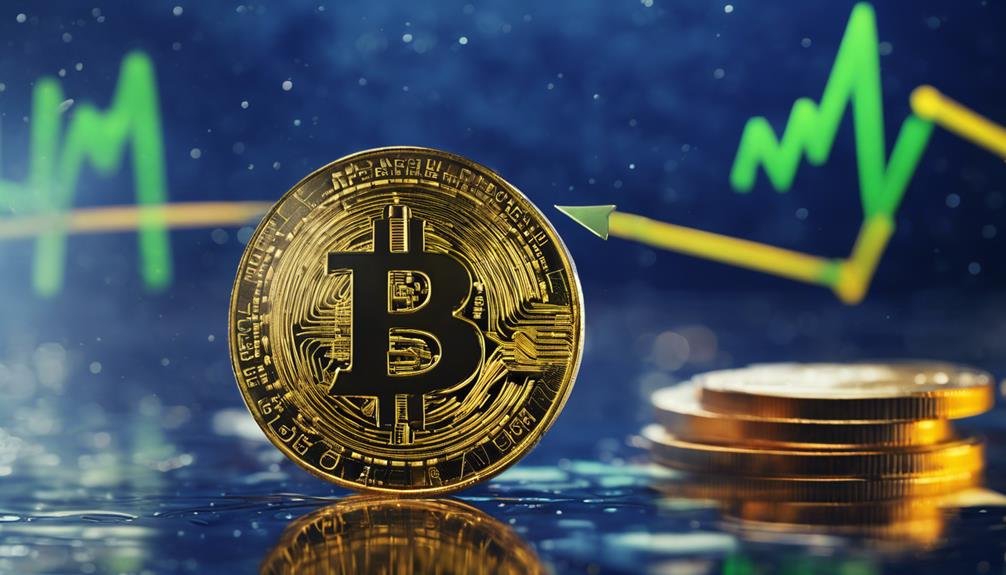Oil prices and cryptocurrency trends are closely tied to global economic insights. Monetary policy decisions, such as interest rate hikes, impact crypto asset prices and investor risk appetite. Rising oil prices affect disposable income, consumption, and crypto market dynamics. Cryptocurrencies attract investors as a hedge against inflation, and central banks’ actions influence market trends. Financial stress and market volatility are closely monitored, as crypto assets are safe havens during economic uncertainty. Understanding the interplay between oil prices, interest rates, and crypto trends is essential for maneuvering economic shifts. As global economic trends continue to evolve, these relationships’ complexities will become sharper focus.
Table of Contents
Brief Overview of Oil Price Fluctuations And Crypto Market Trends
- Rising oil prices negatively impact the global economy, decreasing risk appetite and lowering crypto asset prices.
- Central banks’ interest rate hikes in response to oil price surges can increase crypto market volatility and diminish its appeal as an inflation hedge.
- Higher oil prices reduce consumers’ purchasing power, hindering economic growth and potentially triggering a decline in crypto prices.
- The interplay between oil prices and interest rates affects crypto trends as central banks balance inflation and economic growth concerns.
- Understanding the correlation between oil prices and crypto trends is crucial for investors to make informed decisions and navigate economic uncertainty.
Monetary Policy Impact on Crypto
As the global economy navigates the complexities of monetary policy, an important question arises: how do shifts in interest rates and central banks‘ decisions influence the volatile world of cryptocurrencies? The answer is understanding the intricate relationship between monetary policy and investor behavior. During periods of vital monetary policy characterized by low interest rates, investors tend to take on more risk, driving up crypto asset prices. Conversely, tight monetary policy, marked by rising interest rates, can decrease risk appetite, causing a downturn in crypto markets.
Crypto assets, also known as cryptocurrencies, are often seen as a hedge against inflation, attracting investors during periods of economic uncertainty. However, when central banks raise interest rates to combat inflation, the appeal of cryptocurrencies as a hedge diminishes. This can result in a decline in crypto asset prices. The US Dollar’s inverse correlation with crypto asset prices further exacerbates this effect. As monetary policy influences investor behavior, it is essential to recognize its significant impact on the crypto market. By understanding these dynamics, investors can make more informed decisions in this rapidly evolving landscape.
Oil Price Fluctuations and Crypto
Rising oil prices, exemplified by the 30% surge in WTI crude this quarter, have historically had a significant impact on the global economy, and it is essential to examine how these fluctuations affect the cryptocurrency market. The recent rally in oil prices, with Brent crude oil also experiencing a substantial increase, could have far-reaching consequences for the economic landscape. Higher oil prices may increase retail fuel prices, affecting disposable income and consumption. This, in turn, could complicate the delicate balance between economic growth and inflation expectations.
Notably, investor appetite for risk assets, including cryptocurrencies, has weakened in the past 18 months amid surging oil prices. As central banks consider raising interest rates to combat inflation, the cryptocurrency market may experience further volatility. The interplay between oil price fluctuations and the crypto market is complex, with the former potentially influencing the latter’s performance. Understanding this dynamic is crucial for investors and policymakers navigating the intricate web of global economic trends.
Inflation Hedge and Dollar Influence

One of the most fascinating aspects of the relationship between oil prices and crypto trends is that cryptocurrencies can effectively hedge against inflation despite their historical lack of correlation with inflation expectations. Considering the current economic landscape, inflation concerns are rising, and this concept gains significance. Intriguingly, crypto assets have demonstrated their potential as a safe haven during periods of economic uncertainty, particularly in developing nations where they are adopted to stabilize assets.
The dollar’s influence also plays a pivotal role in shaping crypto prices, with a weakening dollar potentially favoring crypto assets. Despite the lack of correlation, cryptocurrencies have shown promise as an inflation hedge, offering a unique value proposition to investors seeking to diversify their portfolios. As financial markets navigate the complexities of inflation and economic uncertainty, the role of crypto assets as a hedge against inflation will be closely observed.
Financial Stress and Market Volatility
Financial stress and market volatility have emerged as significant factors influencing the performance of crypto assets, underscoring the need for investors to monitor these indicators closely. As financial stress increases, crypto prices tend to decline, highlighting the importance of monitoring stress indicators for potential market impacts. The performance of crypto assets is closely tied to the overall health of financial markets, and stress in these markets can have far-reaching consequences for crypto investors.
In developing nations, crypto assets are not just an alternative to holding domestic currencies in economies with high inflation. They are a beacon of hope, promoting financial inclusion and providing a hedge against economic uncertainty. As financial stress and market volatility continue to shape the crypto landscape, this inspiring trend is one that investors should closely monitor and adapt their strategies to.
Crypto Assets as Safe Havens

During economic turmoil, crypto assets have increasingly been sought as safe-haven instruments, mirroring the traditional role of gold and other precious metals. This trend was evident during the COVID-19 pandemic when cryptocurrencies like Bitcoin and Ethereum demonstrated their potential as safe-haven assets alongside gold. In times of market turmoil, crypto assets such as Bitcoin, Litecoin, and Monero have found safe-haven support in gold, highlighting their hedging capabilities.
The resilience of crypto assets during economic uncertainty makes them attractive as diversification assets, allowing investors to mitigate risk. As safe-haven assets, crypto assets and gold can serve as a hedge for each other, providing a buffer against market volatility. The correlation between crypto assets and gold during financial crises underscores their potential as a store of value. As the global economy navigates uncertain times, the role of crypto assets as safe havens is likely to become more prominent, offering investors a means to weather financial storms.
Oil Price Shocks and Financial Assets
Against a fragile economic recovery, the recent surge in WTI crude oil prices has sparked concerns about its potential impact on financial assets, including cryptocurrencies. The 30% increase in oil prices this quarter has the potential to influence inflation and interest rates, which could have a ripple effect on traditional assets and crypto assets alike.
- Higher oil prices can increase retail fuel prices and key inflation metrics, affecting disposable income and consumption.
- The recent rally in oil prices could exacerbate price pressures and influence central bank rate decisions, potentially triggering market risk sell-offs.
- Rising oil prices may complicate the balancing act between economic growth and inflation, decreasing investor appetite for risk assets, including cryptocurrencies.
As oil price shocks continue to impact the global economy, investors will closely watch how financial assets respond. With both traditional and crypto assets vulnerable to rising oil prices, it remains to be seen how the markets will adapt to this new reality. One thing is sure, however: the current surge in oil prices has set the stage for a complex and potentially volatile period for financial assets.
Market Interactions and Safe Havens

As market uncertainty intensifies, investors have increasingly turned to alternative safe-haven assets, seeking refuge in the volatility of traditional markets. Crude oil prices, crypto assets, and traditional financial assets have been at the forefront of this shift. During economic uncertainty, gold and USD have traditionally served as reliable safe-haven assets for conventional markets. However, the COVID-19 pandemic revealed that cryptocurrencies like Bitcoin, Litecoin, and Monero can find safe-haven support in gold, highlighting their potential as hedge and diversification assets.
Additionally, Brent crude oil was a solid safe-haven asset for Bitcoin during the pandemic, underscoring the complex market interactions. As economic uncertainties impact financial markets, gold and crude oil exhibit safe-haven characteristics, providing a buffer against market turmoil. This dynamic highlights the importance of understanding the intricate relationships between traditional financial assets, crypto assets, and commodity prices in managing risk and achieving diversification. By recognizing these market interactions, investors can better navigate the complexities of global economic trends.
Crypto Market Trends and Global Economy
While monetary policy decisions have far-reaching implications for the global economy, they also profoundly influence the trajectory of crypto market trends. The actions of central banks, particularly the US Federal Reserve, have a ripple effect on global financial markets, including the crypto asset market.
- Loose monetary policy periods, characterized by low interest rates, tend to coincide with bull runs in the crypto market as investors seek higher-risk, higher-reward assets.
- Conversely, tightening monetary policy, marked by rising interest rates, may lead to declining crypto asset prices as investors become risk-averse and seek safer havens.
- The inverse correlation between the US dollar and crypto asset prices also plays a significant role in shaping market conditions, as a strong dollar often corresponds to a weaker crypto market.
In this context, it is imperative to consider the interplay between macroeconomic factors, central banks, and crypto market trends. Understanding these relationships will be essential for investors seeking to make informed decisions in the crypto asset market as the global economy continues to evolve.
Surging Oil Prices and Interest Rates

Rising oil prices have injected a new layer of complexity into the intricate web of macroeconomic factors influencing crypto market trends, potentially exacerbating the impact of interest rate hikes on risk assets. The recent 30% surge in WTI crude oil prices this quarter has raised concerns about a rebound in inflation, prompting central banks to ponder further interest rate hikes. This could hurt risk assets like cryptocurrencies, which have historically been sensitive to changes in interest rates.
As central banks work to combat inflation, they may maintain elevated interest rates for extended periods, complicating the balancing act between economic growth and inflation. Higher oil prices could also hinder economic growth, as increased production costs are passed on to consumers, reducing their purchasing power. As the global economy navigates this complex landscape, investors will closely watch the interplay between oil prices, interest rates, and cryptocurrencies, seeking to make informed decisions in an increasingly uncertain market.
Frequently Asked Questions
What Is the Correlation Between Oil and Crypto?
The correlation between oil and crypto is complex, influenced by market volatility and economic indicators. When oil prices surge, crypto markets often experience fluctuations as investors seek safer assets. However, crypto market trends can decouple during high oil market volatility, offering investment opportunities for those willing to take on risk. Market speculation and global financial impacts also play a role, as price fluctuations in one market can have ripple effects on the other.
What Is the Forecast for Crypto Assets?
As the crypto market navigates uncharted territories, the forecast for crypto assets remains uncertain, like a ship lost at sea. Market volatility, regulatory challenges, and security concerns continue to shadow the industry. However, institutional adoption and decentralized finance may provide a lifeline. Despite price manipulation threats, market capitalization is expected to grow slowly. As the landscape evolves, careful analysis is essential to charting a course through the choppy waters ahead.
Why Is Cryptocurrency Becoming More Popular for Investors and Consumers?
Cryptocurrency’s growing popularity stems from its ability to provide financial freedom through investment diversification and a hedge against market volatility. As digital assets, they offer a decentralized store of value, leveraging blockchain technology for secure and transparent transactions. Consumer adoption is increasing, driven by the appeal of lower transaction costs and faster settlement times. However, regulatory challenges remain, and investors must navigate these complexities to fully realize the benefits of cryptocurrency investments.
How Many Crypto Users Are There in the US?
In the US market, crypto adoption is rising, with approximately 46 million users, expected to reach 53 million by 2025. Investor demographics show that 60% of users are under 34, indicating a youthful enthusiasm for digital assets. Growth trends suggest a steady increase in adoption, driven by consumer behavior and favorable market opportunities. However, the regulatory landscape remains a critical factor in shaping the future of crypto in the US.
Conclusion
Monetary Policy Impact on Crypto
The delicate dance between monetary policy and crypto markets is a fascinating spectacle. Armed with interest rates and quantitative easing, central banks shape the global economy‘s trajectory. Crypto assets, touted as decentralized and free from government control, surprisingly respond to these policy decisions. A hawkish monetary stance, characterized by rate hikes, can stifle crypto growth as investors seek safer havens. Conversely, dovish policies can fuel crypto rallies as liquidity floods the market.
Oil Price Fluctuations and Crypto
Oil prices, a bellwether for global economic health, have an intriguing relationship with crypto markets. When oil prices plummet, crypto assets often thrive as investors seek alternative stores of value. Conversely, surging oil prices can trigger inflation fears, prompting investors to flee riskier assets like crypto. This inverse correlation is not absolute but highlights the complex interplay between traditional markets and crypto.
Inflation Hedge and Dollar Influence
Crypto assets, particularly Bitcoin, are often touted as an inflation hedge, a reputation bolstered by its limited supply and decentralized nature. However, this narrative is challenged when the dollar strengthens, as a robust greenback can dampen crypto prices. The dollar’s status as a global reserve currency underscores its significant influence on crypto markets, making it a critical factor to contemplate.
Financial Stress and Market Volatility
Financial stress, manifesting as market volatility, can have far-reaching consequences for crypto assets. During times of turmoil, investors seek safe havens, often driving up demand for assets like gold and, by extension, crypto. However, this increased demand can lead to exaggerated price swings, making crypto markets notoriously volatile.
Crypto Assets as Safe Havens
Crypto assets, particularly Bitcoin, are increasingly considered safe-haven assets traditionally reserved for gold and other precious metals. Crypto’s decentralized nature, limited supply, and portability reinforce this perception. However, this narrative has challenges, as crypto’s volatility and regulatory uncertainty undermine its safe-haven credentials.
Oil Price Shocks and Financial Assets
Oil price shocks have a profound impact on financial assets, including crypto. Sudden and drastic changes in oil prices can trigger market instability, prompting investors to reevaluate their portfolios. Crypto assets, as a relatively new and untested asset class, are particularly susceptible to these shocks, which can lead to dramatic price swings.
Market Interactions and Safe Havens
The intricate web of market interactions is critical to understanding crypto’s role as a safe haven. When traditional assets, such as stocks and bonds, experience turmoil, investors often flock to perceived safe havens like crypto. However, this increased demand can create a self-reinforcing cycle where crypto prices surge, further solidifying its safe-haven reputation.
Crypto Market Trends and Global Economy
Crypto market trends are inextricably linked to the global economy. As the global economy expands, crypto markets often follow, driven by increased adoption and speculation. Conversely, economic downturns can trigger crypto market corrections as investors become risk-averse. This symbiotic relationship underscores the importance of monitoring global economic trends to better understand crypto market dynamics.
Surging Oil Prices and Interest Rates
The dual threat of surging oil prices and rising interest rates can devastate crypto markets. As oil prices climb, inflation fears intensify, prompting central banks to hike interest rates. This one-two punch can stifle economic growth, triggering a flight to safety and, subsequently, a crypto market downturn.
The intricate dance between oil prices, monetary policy, and crypto markets reveals a complex web of interactions. As the global economy navigates the treacherous landscape of inflation, interest rates, and financial stress, crypto assets will continue to appreciate.




